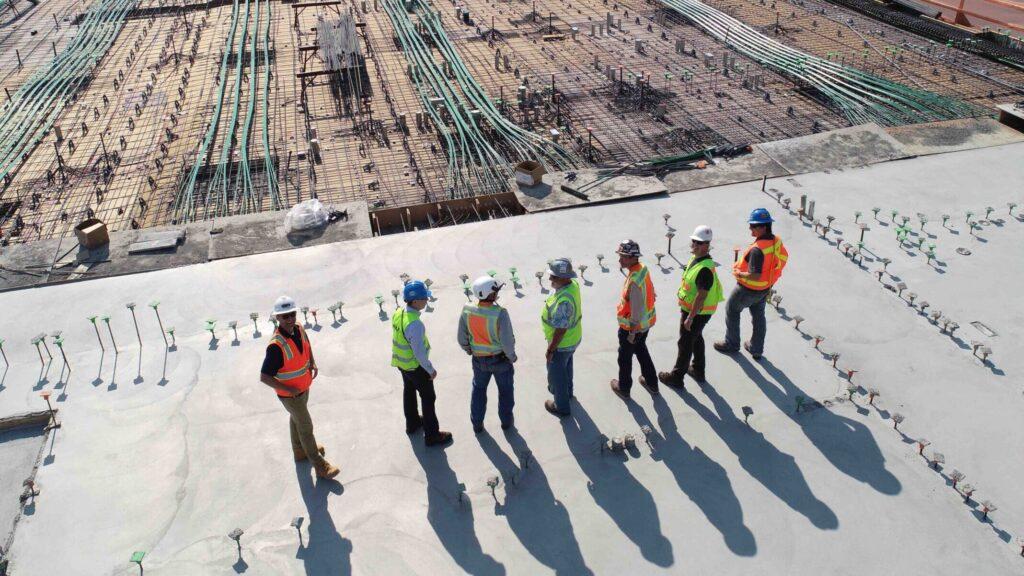Three Georgetown University researchers this year published a study in Communications Engineering, a journal from the Nature Portfolio, detailing policies to mitigate the climate impact and carbon dioxide emissions of the cement industry.
The cement industry accounts for roughly 8% of global carbon dioxide emissions — and reducing these emissions will greatly help to mitigate the climate crisis.

Postdoctoral research fellow Ankita Gangotra, physics professor Emanuela Del Gado and associate professor of energy and environment Joanna Lewis researched the utility of cement-based construction 3D Printing (C3DP) in lowering the greenhouse gas emissions of the cement industry. C3DP is a process in which a building or other structure is built layer by layer using concrete or some other cement-like material in a computer-controlled process similar to 3D printing.
“C3DP changes the context, with respect to traditional construction technology, in which cement, concrete and other construction materials need to be used,” Del Gado wrote in an email to The Hoya. “It is not just about pouring and waiting for the paste to solidify, but it is instead a dynamical process during which successive layers of materials are deposited while flowing, needing to solidify over a given time to support the next layer, while remaining fluid enough to strongly weld with it.”
Despite the fact that cement only makes up 10 to 15% of concrete — with the rest coming from water, sand and gravel — its carbon footprint is immense, according to Gangotra.
“About 80% of the emissions from the entire supply chain of cement and concrete comes from the production of cement, so if you use supplementary cementitious materials or different cementitious mixtures, you can see a reduction in the emissions,” Gangotra told The Hoya.
Gangotra said C3DP technology can help reduce emissions by lowering concrete and cement demand.
“Let’s say you have a pillar. You might go ahead and actually make the pillar hollow or hybridized in a way that means that it’s structurally sound but does not use as much of the material. Usually that’s done to save on time and cost, yet that means that it also has a net climate benefit,” Gangotra said. “Unlike most 3D printing techniques, it’s the material itself that contributes the most to the entire carbon footprint, as opposed to the energy used in printing.”
Gangotra, Del Gado and Lewis recommend five policy proposals in the following categories: research and development, information dissemination and workplace development, standards and codes, public procurement and partnerships, and financial and structural incentives.
“It’s got untapped potential. Climate policymakers haven’t really been focusing on it because we’re still trying to unleash its potential,” Gangotra told the Hoya. “We can see between a 40 to 78% reduction in emissions.”
In an email to The Hoya, Del Gado explained that one of the most exciting opportunities in terms of scientific development includes “the possibility to pivot, through C3DP, toward greener cement formulations and even more sustainable, smarter concrete mixes.”
The researchers called for additional funding for studies regarding cementitious mixtures and structural design that could be used in C3DP, as additional studies could prove to be essential in maximizing the carbon dioxide efficiency of C3DP technologies.
An important aspect of research into C3DP’s climate impact is life cycle analysis, which evaluates the environmental impact of a project across its entire lifespan. This is because the structure could require less upkeep — and could last much longer than a structure made with other materials.
“You could have a material that has a higher than normal carbon footprint but still get lower emissions,” Gangotra said.
Regulations and codes are vital to ensure the technology is actually used to its full climate potential. The researchers therefore recommend instituting industry guidelines and standards for C3DP technology, such as what cementitious mixtures to use and how to minimize material waste.
Utilizing C3DP tec
hnology in public-private partnerships could also increase the climate impact of the technology by expanding its use, according to Gangotra.
“Governments haven’t been looking at the technology from a climate-focused lens. So that was really how this paper came about,” Gangotra said.
According to Del Gado, C3DP technology could completely change the landscape of modern construction.
“In terms of potential impact for C3DP, it is difficult to provide numbers but, to get a sense of the scope, one interesting fact is that 3D printing technologies for construction are being looked at as the main option for construction in space,” Del Gado told the Hoya
“The demands of C3DP technology create a truly interesting space for new products, such as recycled and low-carbon mixtures, and new functionalities, such as self-healing and ultra-tough concrete, which have had so far limited space in the concrete industry,” Del Gado also said.
Offering economic incentives will also increase the use of C3DP technologies and thus hopefully increase their efficiency. The paper proposes awarding tax credits, loans and other incentives to the private sector.
Cement and concrete are some of the most used materials on Earth, meaning any reduction in the emissions that stem from their use will enormously benefit the planet.
Gangotra said it is up to policymakers to take advantage of the technology that they proposed in their study.
“The technology is ripe to enact climate mitigation policies to make sure that we steer it in a direction that unleashes its full climate potential,” Gangotra said.













